The Mystic Chakra of Sharika Mata (Tripuasundari) at Hari Parbhat
“Hari Parbhat” also known as “Sharika peeth” is one of the most holiest sacred Place for the Hindus of Kashmir. Legend says that at this Place, Goddess Sharika killed the demon “Jalodbhava”. The Goddess in the form of “Haer”(Myna) at the behest of her devotees dropped a Pebble from above on Jalodbhava. The pebble became larger and larger. When it Hit the Demon, the pebble had grown to the size of a Hill.The Demon was crushed under the Hill. The Hill that dropped on the Demon came to be known as “Hari Parbaht”. The Mother Goddess resides there by the name of “Sharika” or “Tripursundari”. The eighteen-armed Goddess is considered as the presiding deity of the Srinagar city. She resides here in the form of syambu “Sri-Chakra”, also known as “Maha yantra”.This mystic Chakra is self-engraved on the Holy Shila( a vertical rock smeared in sindoor).Since the Divine Mother resides in the form of a “Chakra”, hence, she is also locally known as “Chakeshwari” and the place/temple as “Chakrieshwar”.
The significance of Sri-Chakra , is written on a Board in the premises of the temple. I am merely reproducing it verbatim.
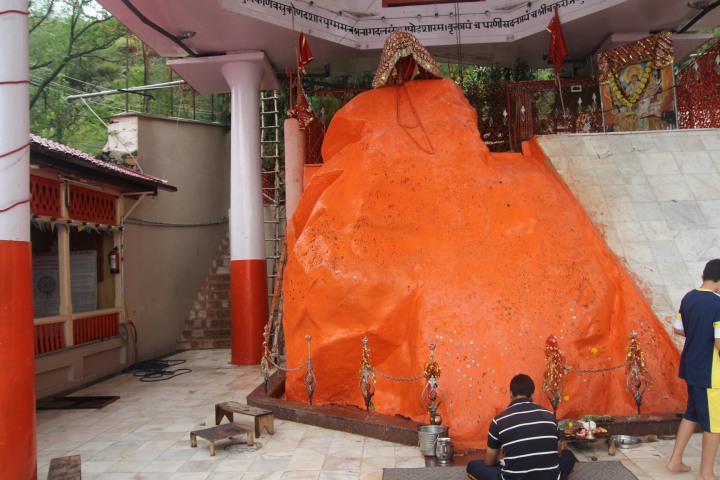
The sacred “Sri Chakra”, commonly known by the Hindus as “Sri Yantra” is composed of circles and the lotus petals, contains nine independent trikonas(Triangles), mystically drawn within the other. The four Triangles that point upwards represent “Shiva” and the other five pointing downwards represent “Shakti”.The Shiva Triangles are called “Sri Kanthas” or Shiva element, and the Shakti triangles are known as “Shiva-yuvatis” or Shakti element. All these are quite independent of the central Bindu and are formed by the Mulaprakrati of Shiva Bindu.
The intersecting triangles represent the play of creation, protection and absorption of the whole universe by the pure divine force known as “Sudha Shakti”.The central point in the Chakra is Bindu which symbolizes the union of “Shiva with Shakti” or “Kameshwar with Kameshwari”.
“Sri Yantra” is, in fact, the most magnificent composition of nine independent trikonas, charged with the supreme occult significance. The Trikonas in their upward and downward positions intersect one another and form themselves into forty three big and small triangles. All these triangles are enclosed in the first inner circle on which is drawn one Lotus with eight petals called “Ashta Dal”, which represents the mystical lotus of creation. The another circle following this with sixteen petalled lotus, drawn on it is called “Shada-shadal”. This Lotus is significant of sixteen kalas or phases of the moon. The whole set of triangles and the Lotus petals are further enclosed in triple concentric circles or three-fold girdles called “Trimekhla”, The whole diagram, forming the mystical chakra, fixed in a square, with triple parallel lines, having four openings or gates on its four cardinal points make up the Devi’s mansion. In the center of the whole composition lies the Bindu(point) which, in fact is the mysterious matrix of the Maha-Yantra. The description of this “Yantra” is given in sloka 11 of “Sundaryalahri”, reproduced just below the Yantra itself.
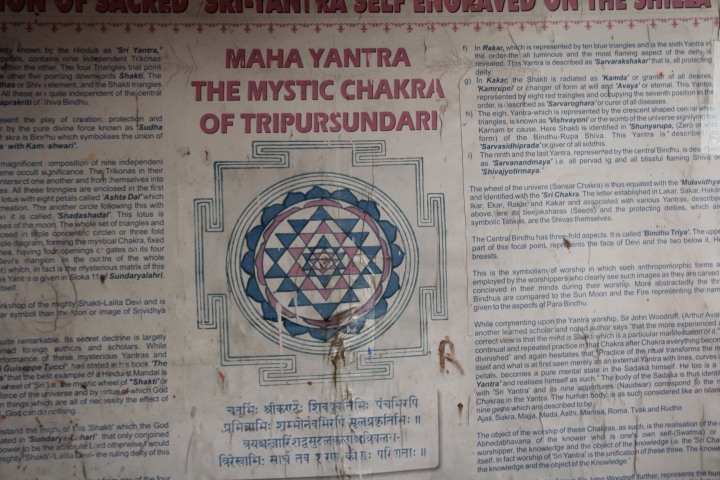
The “Yantra” is adopted for the worship of the mighty “Shakti-Lalita Devi” and is considered to be the most popular symbol that the Icon or image of “Srividhya” i.e “Tripursundari” herself.
The mystery of “Sri Yantra” is quite remarkable. Its secret doctrine is largely acknowledged even by the renowned foreign authors and scholars. While acknowledging the mystical performance of these mysterious Yantras and Mandals, a foreign Scholar “Shree Guiseppe Tuccti” has stated In his book, “The theory and practice of Mandals” that the best example of Hinduist Mandal is the one called “Sri Chakra” or the wheel of “Sri” i.e the mystic wheel of “Shakti” or divine power, which is the motive force of the universe and by virtue of which God manifests and displays himself in things which are all of necessity the effect of Shakti itself. Since without “Shakti”, God can do nothing. One can well imagine and understand the might of this “Shakti”, which the God himself has acknowledged as stated in “Sundarya-Lahiri” that only conjoined with thee Oh! “Shakti” have I the power to be the absolute lord otherwise I would not be able to move. Such is the mighty “Shakti-Lalita-Devi”, the ruling Deity of this celebrated “Maha Yantra”.
The “Yantra” can be described in two ways.It may be started from any of the four gates of outer Chakra and worked inwards towards the central Bindu or in the reverse order, It may be started from the Bindu and worked outwards towards the gates. The former process is called “Layakrama”(involution) and the latter “Srashtikrama”(Evolution). Here it is described in the latter way.
Starting from the central point (Bindhu) and ending with the for gates the whole complex is divided into nine Chakras or wheels called Yantras which according to “Tantraja Tantra” are:-
1.Central Red Bindu, described as ……………………………………………………………………………………………Sarvanandmaya.
2. Central White Triangle, described as…………………………………………………………………………………….Sarvasidhipradha.
3.Eight red Triangles, described as ……………………………………………………………………………………………Sarvaroghara.
4.Ten Blue Triangles, described as…………………………………………………………………………………………….Sarvarakshakar.
5.Ten Red Triangles, described as……………………………………………………………………………………………..Sarvarthasadhak.
6.Fourteen blue triangles, described as ……………………………………………………………………………………Sarvasaubnagyadayak.
7.Eight Red Lotus petals, described as……………………………………………………………………………………….Sarvasamksobhan.
8.Sixteen blue lotus petals, described as …………………………………………………………………………………..Sarvaparipuraka.
9.Surrounding Yellow ground between the outer most circle and four gates……………………………Trilokyamohan.
Explaining the complex of these yantras the sacred, “Tripuramahimstrotam” says that the same “Mulavaidyaksars” as having contributed towards the unfolding of this “Sri Yantra” are responsible for the evolution of this universe as well, when it says that:-
(a) From the “Lakar”, which, according to “Laya-Krama” represents the first outer chakra i.e the yellow surrounded ground, This “Pararupa” earth on which we live has been born and on which there are Mountains, Forests, Grooves, fifty peetas(Seats), all places of pilgrimages, all Ganges, all “Khetrasthanas”, this chakra is known as “Trilokyamohan”, that is the Enchanter of the Universe.
(b) From “Sakar”, representing the second chakra of sixteen blue petalled lotus, it took the form of the Moon, Stars, Planets, Zodiac(Rashi Chakra).This Yantra is described as “Sarvasanksobhan”.
(c) In “Ikar”, which is represented by the fourteen blue triangles, It is “Turyamaya” or the creator of the universe. This yantra being fourth in the order is described as “Sarvasaulhagvadayak” i.e all auspicious.
(d) In “Ekar”, which obtains the fifth place in the order and it is represented by Ten Red Triangles the “Vishavi Shakti” manifests herself as one engaged in “Vaishvaplan” (preservation of the universe). This Yantra is described as “Sarvarthasadak” or fulfiller of all desires.
(e) In “Rakar”, which is represented by ten blue triangles and is the sixth yantra in the order, the all luminous and the most flaming aspect of the deity is revealed.This Yantra is described as “Sarvarakshakar”-That is all protecting deity.
(f) In “Kakar”, the shakti is radiated as “Kamda” or granter of all desires, “Kamrupni” or changer of form at will and “Avaya” or eternal. This Yantra, represented by eight red Triangles and occupying the seventh position in the order, is described as “Sarvaroghara” or curer of all diseases.
(g) The eighth Yantra which is represented by the crescent shaped central white triangles is known as “Vishvayoni” or the Womb of the Universe signifying the Karnam or the cause.Here Shakti is identified in “Shunyarpa” (Zero or void form) of the Bindhu Rupa Shiva. This Yantra is described as “ Sarvasidhiprada” or giver of all Siddhis.
(h) The ninth and the last Yantra, represented by the central Bindu, is described as “Sarvanandmaya” i.e all pervading and all blissful flaming Shiva or “Shivajyotimaya”.

The wheel of the universe( Sansar Chakra) is thus equated with the “Mulavidya” and identified with the “Sri Chakra”.The letter established in Lakar,Sakar, Hakar, Ikar, Ekar, Rakar, and Kakar and associated with various Yantras described above, are its “Beejaksharas”(seeds) and the protecting deities, which are symbolic tattwas, are the Shivas themselves.
The central Bindu has three fold aspects. It is called “Bindu Triya”.The upper part of this focal point, represents the face of Devi and the two below it, her breasts. This is the symbolism of worship in which such anthropomorphic forms are employed by the worshippers who clearly see such images as they are carved or conceived in their minds during their worship. More abstractedly the three Bindus are compared to the Sun, Moon and the fire representing the names given to the aspects of “Para Bindu”.
While commenting upon the Yantra worship, Sir John Woodroff, (Arthur Avalon) another learned Scholar and noted Author says, “that the more experienced and correct view is that the mind is shakti, which is a particular manifestation of it. By continual and repeated practice in that Chakra after Chakra everything becomes divinized” and again hesitates that “Practice of the ritual transforms the mind itself and what is at first seen merely as an external Yantra with lines, curves and petals, becomes a pure mental state in the Sadhka himself. He too is a “Sri Yantra” and realizes himself as such.. The body of the Sadhaka is thus identified with “Sri Yantra” and its nine apertures (Naudwar) correspond to the nine chakras in the Yantra. The Human body, is as such considered like an Island of nine gems which are described to be:- Ajas, Sukra, Majja, Meda, Asti, Mamsa, Roma, Tvak and Rudhir. “The object of the worship of these chakras, as such is the realization of the one Abedabhavana of the Knower who is the one’s own self-(Swatma) or the worshipper, the knowledge and the object of the Knowledge i.e the “Sri Chakra” itself. In fact worship of sri yantra is the unification of these three-The knower of the Knowledge and the object of the knowledge.”
“This celebrated yantra”, says Sir John woodruff further, represents the human body, the whole universe and the man for what is in the former is in the latter and vice-versa as also the Shiva Shakti Swarupa or Atma. It is thus the symbol of Devi as she is in her own form (Swarupa) and as she is in the form of the universe (Vishwatma).
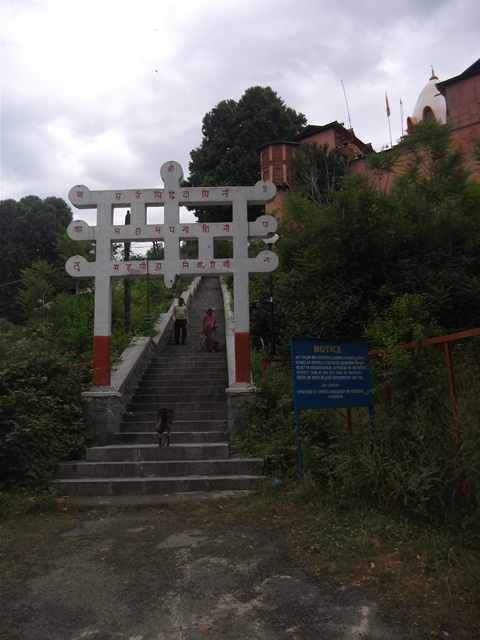

According to the TANTRAJA TANTRA, there are 960 yantras which are assigned to ADYA, NITYA AND LALITA, the three Goddesses, who are known as “Tripurasundari”. Conjoined in one.
Different fruits are gained by worshipping different Yantras. Of the 960 Yantras the principal one’s are:- Sri yantra, Puja Kamal Chakra, Amritghat, Siddhavajra, Kesthavajra, Wajralinga, Merulinga, Yoni, Vajravajrak, Maha Vajra and Vajra.
Yantras are purely linear diagrams. They are drawn provisionally or permanently. When it is desired to be drawn permanently, It is inscribed on a stone or on copper or Bronze Plates that are often seen in Hindu temples, Shrines and other places of worship. Righteously, the Yantra deserves a place in every Hindu Home if one desires to be happy, prosperous and free from ailments.
Hari Parbat—-a memoir
JAN 1988,Rainawari,Srinagar……
It is the month of January in Srinagar, Kashmir and I am awakened by my Paternal Grandmother, My wrist watch shows 5.00a.m in the morning, I rub my eyes and see my Brother already up and smiling at me. It is the month of Magh which is considered auspicious by all the Kashmiri Pandits and many devout KP’s throng to Mata Sharika’s Mandir ,which is also known as “Hari Parbat”, to invoke her blessings.
It is freezing cold outside and I have put on my Pheran(Traditional dress of kashmiris used in winter), with a fur cap on my Head and woolen gloves to cover my hands, I feel protected to some extent from the cold of horrendous winter of Kashmir. We move some 50 meters from our Home and stop outside our neighbors house, It is pitch dark and silent , suddenly my Grandmother coughs,” ahhoo,ahhoo”and wait for some seconds and then again she repeats the artificial cough, ”Ahhoo, Ahhoo”, This time I hear the sound of same type of cough , ”Ahhoo, Ahhoo” coming from inside. My Grandmother says to us,” They are coming out within few seconds”, I see 3-4 dark images coming from gate of our neighbor’s home. We are joined by our friend also who is of our age as he greets us with excitement.
The group walks swiftly towards Bagh Jogi Lankar and many a times the atmosphere is filled with the Barks of Street Dogs that are ubiquitous throughout our Journey. Since we are now a group of 8 people, there is nothing to fear about those ferocious Dogs that had the dubious distinction of biting lone strangers who ventured into their territory.
We again Stop in front of Post Office and Again my Grandmother repeats the same procedure of coughing, this time however a couple of elderly Gentlemen emerge from the Dark sub lane. Now we are a bigger group with 5 males including us(I, my brother and friend) , There is hardly any conversation between the members ,the group walks at a good pace until we reach Malkah(Burial Ground).We amble through probably the biggest Graveyard of Muslims of Kashmir as I overlook and pass through thousands of Graves until I am greeted by the wall which encircles Hari Parbat, this wall must be running over several Kilometers. I along with the group pass through the opening of that wall and walk further until all the elders stop at a point. It is Maqdoom Saab, a Sufi Saint of Kashmir who is revered equally by Hindus and Muslims of Kashmir, though we don’t go up the stairs but all of us bow our heads in reverence. Some meters further , I see hundreds of burning lamps(Ratandeep/Diyas) and I soon realize that we have reached Ganpat/Ganesh Mandir. We all lit the diyas(lamps) in front of the idol of Ganpatji.The Ganeshji here is present in the form of a large Boulder smeared with Sindoor(vermilion), Inside the temple there is congregation of hundreds of devotees singing Bhajans that Culminates in the morning Aarti.
The group comes out of the Ganpat Mandir, It is already Dawn, our group walks in the by lanes of that area until we reach a open space. We walk through a dense mini forest at the bottom of the Hari Parbat Hill as I leave behind Kali Mandir which comes en route and walk further, until, I see the first glimpse of the stairs which our group climbs and finally reach the temple compound of Sharika Mata.
Here again a big Boulder smeared with Sindoor, silver and Gold foils represents the power known to us as Goddess Sharika. At the left side of the compound though an idol has also been made by the devotees of Mata, This compound is reverberated by the Bhajans sung by youths who mostly have come from Habbakadal and Rainawari areas , I recognize many faces among that group and recognize some of musical instruments as Harmonium, Tumbaknar and Nout(earthen pot).
The group I am travelling with genuflects in front of the Mata in the open compound, My grandmother and other elders read sholokas/bhajans (Hymns) from the handbooks which they are carrying with them, while we(I, my brother and friend) go inside the covered compound where the singing of Bhajans is going on with full energy and soon ,we also become a part of the chorus.
On our return, the old group disintegrates and now our new group consisted of my grandmother, I and my Brother, My friend and his Mother. We soon left the main Bhawan(compound) and descend a few stairs, though our return route is different from the route we came from. We pass through a nursery planted with saplings and some almond trees, those almond trees looked beautiful especially in the spring when white flowers bloomed on these trees and the fragrance could titillate and intoxicate anybody’s olfactory.
As we walk further , we see a temple which is also known as” Ramchanderun Mandar”(Ram temple), I enter the temple compound and pay my obeisance to Ramchanderji. From this temple I can see beautiful vistas of Nagin lake as well as Hari Parbhat fort. our next stoppage is Pokherbal which is situated at the banks of Nagin Lake.
I don,t have much memory of pokherbal, so I will move forward. We all crossed Kathi Darwaza -That part of the encircled wall which once used to protect the Hari Parbat fort. Our group walks further some meters and then stop at Chatti Padshai Gurdwara, the religious compound that is connected with the legacy of Guru Hargobind singhji, the sixth Guru of Sikhs. As it is a Sunday, we all go inside and in reverence bow in front of the Guru. On Sundays, the sikh volunteers of the Gurudwara serve hot tea to everybody as a part of Sewa, our group also drinks the tea served in steel glasses and feel refreshed.
We again start our journey back to home as our group bypasses Malkha, soon an acrid smell hits us and I cover my nose with the Muffler, I instantly know that we have reached pouj Mahal (Buther colony),the Drains are filled with blood of the sheep, Occasionally we could hear the cries of the dying sheep screaming “mhea, mhea”. our increased pace help us to leave the “pouj mahal” and its acrid smell behind us.
further down, we stop at the Kandur’s shop(Kashmiri Bakery) near hari sing high school and get some hot lavaasa (a sort of kashmiri unleavened bread) from the oven to eat as we(I, my brother and friend) were feeling hungry by now. The Group amble through the bagh jogi lankar Bridge and soon we reach the comfort of our home as I tuck Kangir under my pheran and wait for the Kahwa to be served to me…..




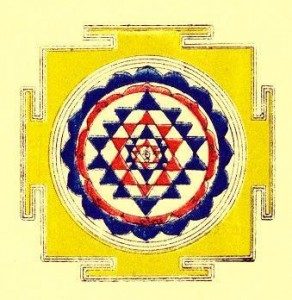
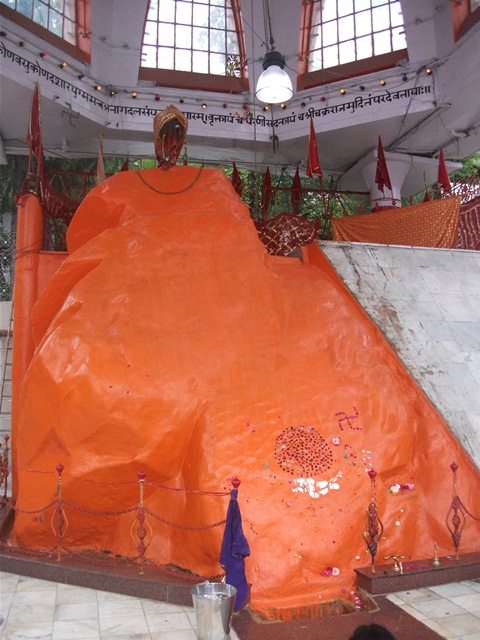















![Validate my RSS feed [Valid RSS]](valid-rss.png)
leave a comment